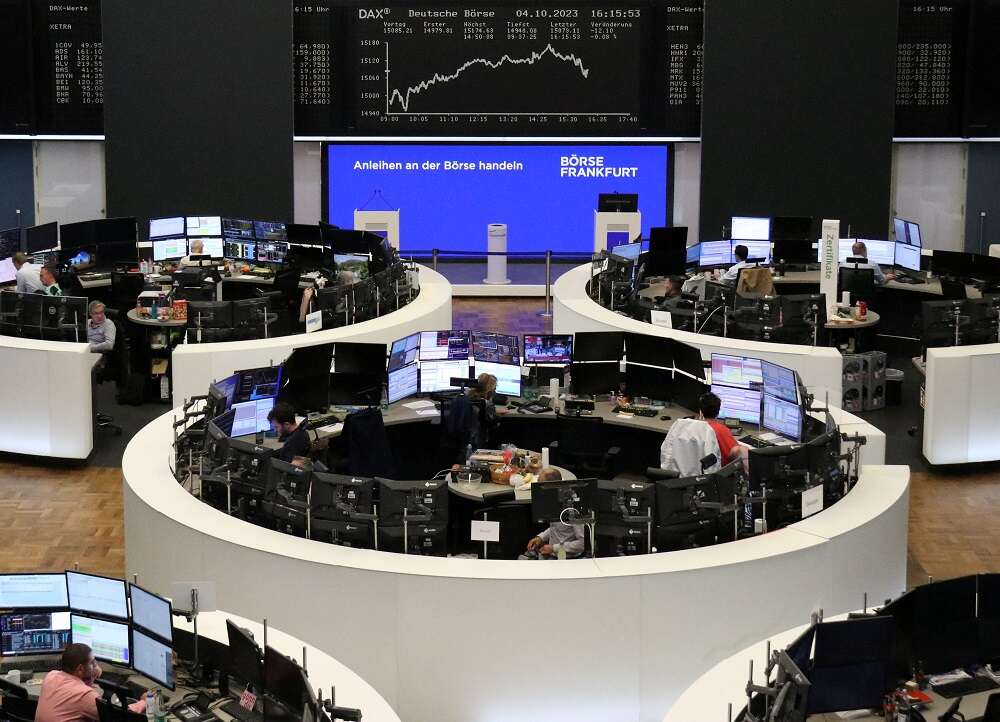
NEW YORK/LONDON (Reuters) -The dollar eased and a gauge of global equities slipped on Thursday as investors grappled with U.S. unemployment benefits data pointing to a still-tight labor market and a Federal Reserve intent on keeping interests rates higher for longer.
European stocks rebounded from three days of losses but Wall Street’s three main indexes fell as investors eyed benchmark Treasuries yields hovering just under 16-year highs before a much-anticipated U.S. jobs report on Friday.
Oil prices extended Wednesday’s sharp losses as the demand outlook remained uncertain, while the market priced in monetary policy that is neither restrictive or expansive.
“The markets have set a little bit higher neutral rate than what maybe the Fed believes it will be,” said Mike Sanders, head of fixed income at Madison Investments in Madison, Wisconsin.
“It’s pretty evident that the jobs market and the consumer are doing OK. Claims are still very, very low,” he said. If claims are up to mid-250,000 by year’s end, “that’s a fairly obvious sign that there’s a loosening of the labor market.”
Initial claims for state unemployment benefits increased 2,000 to a seasonally adjusted 207,000 for the week ended Sept. 30, the Labor Department said. Economists polled by Reuters had forecast 210,000 claims for the latest week.
Long-dated Treasury bonds edged up, the benchmark 10-year hovered near break-even after hitting 4.884% the previous session and shorter-dated notes slipped.
“The question everyone’s asking is: can yields continue to rise further and at what point are yields going to cause some serious damage on the economy?” said Baylee Wakefield, a portfolio manager at Aviva Investors.
“If we’re going to see more positive signs from non-farm payrolls on Friday then we might get investors worrying a little bit less about seeing higher interest rates going into the end of the year.”
Financial markets see the chance of a Fed interest rate hike in November at 22.2% and priced in the U.S. central bank’s overnight lending rate staying above 5% through to June 2024. Earlier this week the target rate was seen above 5% through next September.
The two-year Treasury yield, which reflects interest rate expectations, fell 2.3 basis points to 5.027%, while the benchmark 10-year note yield was down 1.2 basis points at 4.723%.
The dollar index fell 0.234%, with the euro up 0.25% at $1.0529. The yen strengthened 0.40% versus the dollar at 148.50, below the 150 mark seen as a possible threshold that can lead to intervention by the Bank of Japan.
Analysts speculated earlier this week that Japanese authorities may have intervened to support the currency, but Bank of Japan money market data showed on Wednesday that was unlikely.
Despite the dollar’s recent renewed strength, analysts expect weakness, a Reuters poll showed.
MSCI’s gauge of stocks across the globe shed 0.17%, while the pan-European STOXX 600 index rose 0.31%, with the travel and leisure index up 1.5% on the prospect of easing fuel costs boosting airline stocks.
On Wall Street, the Dow Jones Industrial Average fell 0.5%, the S&P 500 lost 0.71% and the Nasdaq Composite dropped 0.85%. All 11 sectors of the S&P index were in the red, with the big megacap growth stocks leading the decline.
Asian shares rebounded from 11-month lows overnight, following Wednesday’s small gains on Wall Street. China’s mainland markets remain closed for holidays.
European government bond yields were mixed, with the benchmark 10-year German yield down 1 basis point at 2.885%. The German curve was its least inverted since March.
U.S. crude fell 2.03% to $82.51 per barrel and Brent was at $84.15, down 1.93% on the day.
“Investors are worried that peak demand for fuel consumption is behind us,” said Dennis Kissler, senior vice president of trading at BOK Financial. “But the market is still going to be undersupplied to the end of the year. It’s searching for an equilibrium.”
Gold prices edged lower for a ninth straight session.
Spot gold dropped 0.3% to $1,815.27 an ounce.
(Reporting by Elizabeth Howcroft;Editing by Elaine Hardcastle, Sharon Singleton and Richard Chang)


